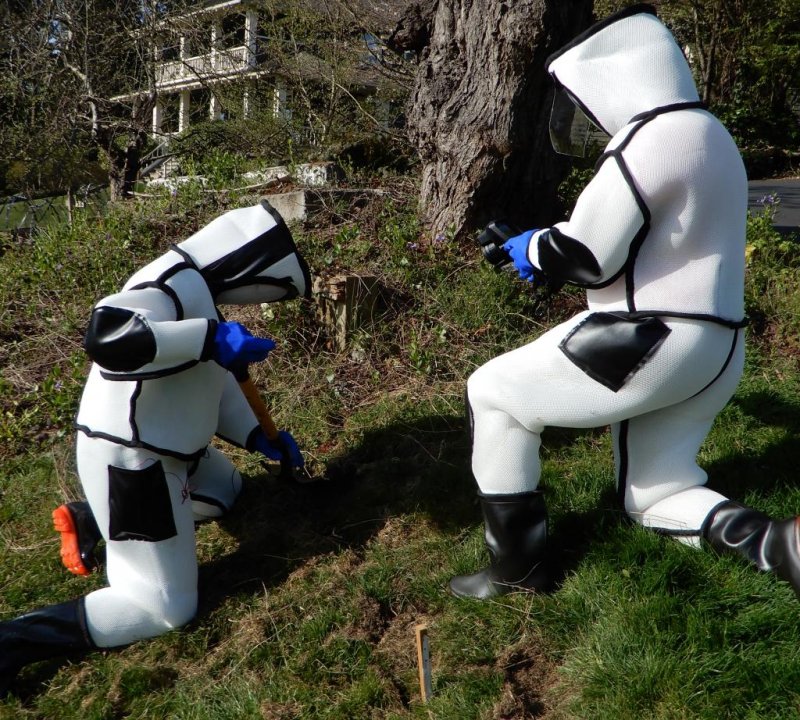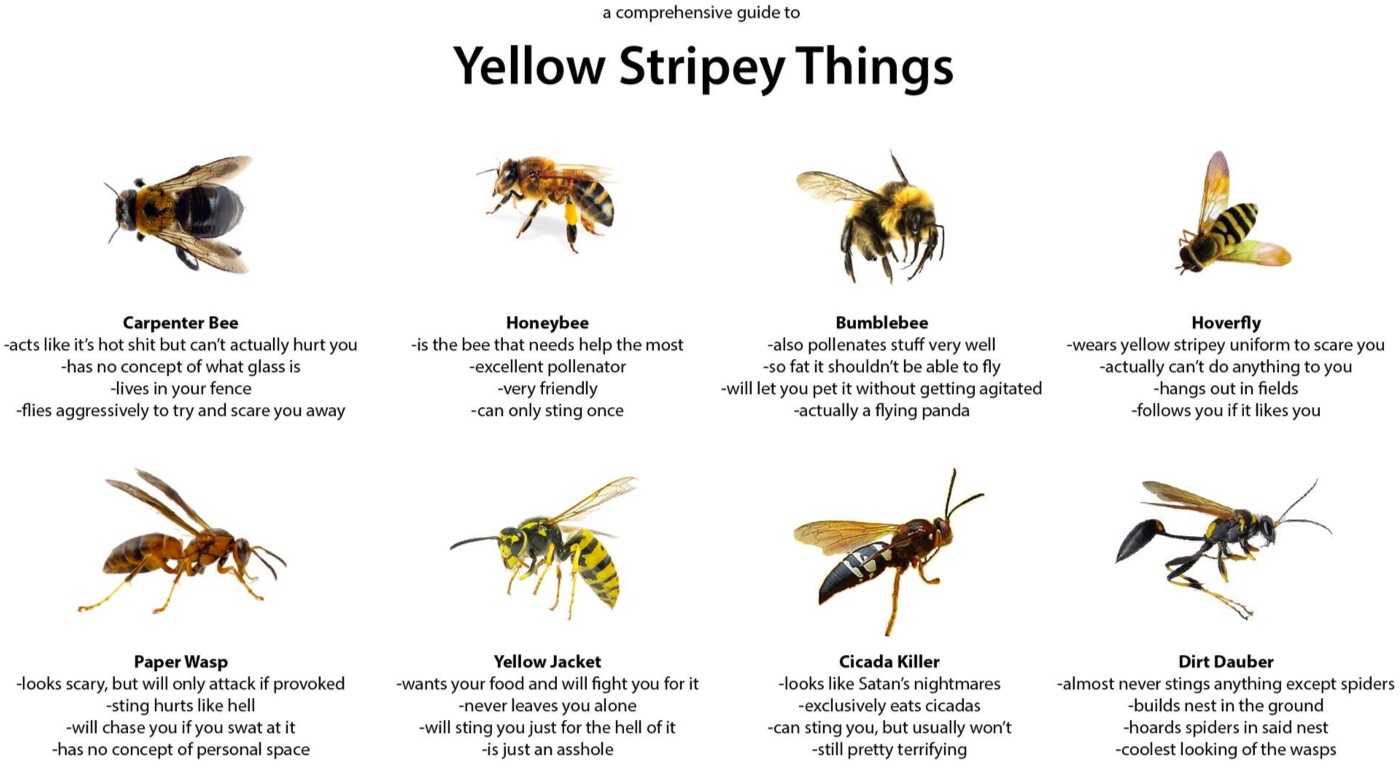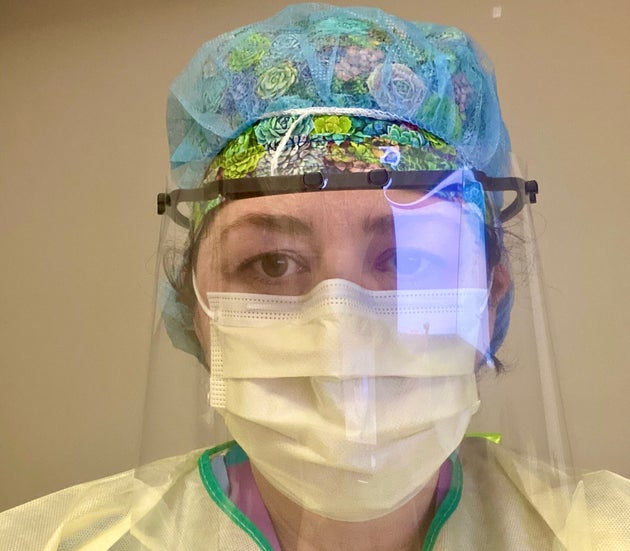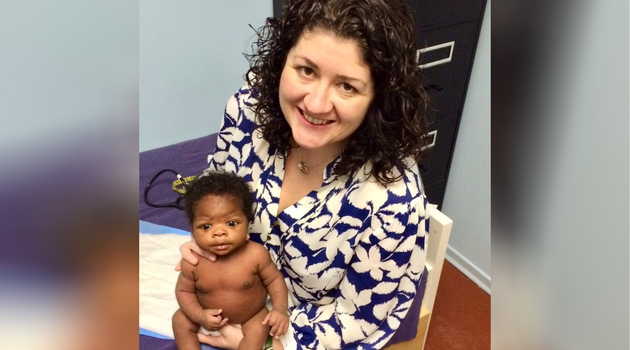'Murder Hornets,’ with sting that can kill, land in US

4 of 6
In this Dec. 30, 2019, photo provided by the Washington State Department of Agriculture, a dead Asian giant hornet is photographed in a lab in Olympia, Wash. The world's largest hornet, a 2-inch long killer with an appetite for honey bees, has been found in Washington state and entomologists are making plans to wipe it out. Dubbed the "Murder Hornet" by some, the Asian giant hornet has a sting that could be fatal to some humans. It is just now starting to emerge from hibernation. (Quinlyn Baine/Washington State Department of Agriculture via AP)
SPOKANE, Wash. (AP) — The world’s largest hornet, a 2-inch killer dubbed the “Murder Hornet” with an appetite for honey bees, has been found in Washington state, where entomologists were making plans to wipe it out.
The giant Asian insect, with a sting that could be fatal to some people, is just now starting to emerge from winter hibernation.
“They’re like something out of a monster cartoon with this huge yellow-orange face,” said Susan Cobey, a bee breeder at Washington State University.
“It’s a shockingly large hornet,” said Todd Murray, a WSU Extension entomologist and invasive species specialist. “It’s a health hazard, and more importantly, a significant predator of honey bees.”
The hornet was sighted for the first time in the U.S. last December, when the state Department of Agriculture verified two reports near Blaine, Washington, close to the Canadian border. It also received two probable, but unconfirmed reports from sites in Custer, Washington, south of Blaine.

In this Dec. 30, 2019, photo provided by the Washington State Department of Agriculture, the stinger of a dead Asian giant hornet is photographed in a lab in Olympia, Wash. The world's largest hornet, a 2-inch long killer with an appetite for honey bees, has been found in Washington state and entomologists are making plans to wipe it out. Dubbed the "Murder Hornet" by some, the Asian giant hornet has a sting that could be fatal to some humans. It is just now starting to emerge from hibernation. (Karla Salp/Washington State Department of Agriculture via AP)
The hornet can sting through most beekeeper suits, deliver nearly seven times the amount of venom as a honey bee, and sting multiple times, the department said, adding that it ordered special reinforced suits from China.
The university said it isn’t known how or where the hornets arrived in North America. It normally lives in the forests and low mountains of eastern and southeast Asia and feeds on large insects, including wasps and bees. It was dubbed the “Murder Hornet” in Japan, where it is known to kill people.
The hornet’s life cycle begins in April, when queens emerge from hibernation, feed on plant sap and fruit, and look for underground dens to build their nests. Hornets are most destructive in the late summer and early fall. Like a marauding army, they attack honey bee hives, killing adult bees and devouring larvae and pupae, WSU said.

BFH!
In this April 23, 2020, photo provided by the Washington State Department of Agriculture, dead Asian giant hornets sit on a researcher's field notebook in Blaine, Wash. The world's largest hornet, a 2-inch long killer with an appetite for honey bees, has been found in Washington state and entomologists are making plans to wipe it out. Dubbed the "Murder Hornet" by some, the Asian giant hornet has a sting that could be fatal to some humans. It is just now starting to emerge from hibernation. (Karla Salp/Washington State Department of Agriculture via AP)
Their stings are big and painful, with a potent neurotoxin. Multiple stings can kill humans, even if they are not allergic, the university said.
Farmers depend on honey bees to pollinate many important northwest crops such as apples, blueberries and cherries. With the threat from giant hornets, “beekeepers may be reluctant to bring their hives here,” said Island County Extension scientist Tim Lawrence.
An invasive species can dramatically change growing conditions, Murray said, adding that now is the time to deal with the predators.

In this April 23, 2020, photo provided by the Washington State Department of Agriculture, a researcher holds a dead Asian giant hornet in Blaine, Wash. The world's largest hornet, a 2-inch long killer with an appetite for honey bees, has been found in Washington state and entomologists are making plans to wipe it out. Dubbed the "Murder Hornet" by some, the Asian giant hornet has a sting that could be fatal to some humans. It is just now starting to emerge from hibernation. (Karla Salp/Washington State Department of Agriculture via AP)
“We need to teach people how to recognize and identify this hornet while populations are small, so that we can eradicate it while we still have a chance,″ Murray said.
The state Department of Agriculture will begin trapping queens this spring, with a focus on Whatcom, Skagit, San Juan, and Island counties.
Hunting the hornets is no job for ordinary people.
“Don’t try to take them out yourself if you see them,” Looney said. “If you get into them, run away, then call us!″

In this April 23, 2020, photo provided by the Washington State Department of Agriculture, Chris Looney, a Washington State entomologist, places a trap used to search for the Asian giant hornet in Blaine, Wash. The world's largest hornet, a 2-inch long killer with an appetite for honey bees, has been found in Washington state and entomologists are making plans to wipe it out. Dubbed the "Murder Hornet" by some, the Asian giant hornet has a sting that could be fatal to some humans. It is just now starting to emerge from hibernation. (Karla Salp/Washington State Department of Agriculture via AP)
Invasive Asian giant hornet discovered in Washington state

Invasive Asian giant hornets, a honeybee-killing wasp with a dangerous sting, have been discovered in Washington. Photo courtesy of the Washington State Department of Agriculture
DENVER, May 2 (UPI) -- Washington agriculture authorities are asking residents to be on the lookout for an invasive giant wasp with an "excruciating" sting that attacks honeybee colonies, leaving thousands of bees without heads.
"The Asian giant hornet been called the most venomous, intimidating insect in the world, and it even scares away other hornets," said Timothy Lawrence, director of the Island County extension office at Washington State University.
Asian giant hornets originating in South Korea were first reported last fall near Vancouver Island in British Columbia. Then, residents in Blaine, Wash., near the Canadian border, used an invasive species app to report wasps that were confirmed to be Asian giant hornets from Japan, the state agriculture department said.
An infestation of the new giant wasps could be devastating for beekeepers who bring their hives to the state to pollinate Northwest Pacific crops like cherries, blueberries and apples.
"Commercial beekeepers have 300 to 400 hives in the area. They may not want to go to certain counties if this infestation takes hold," Lawrence said.
In Europe, the invasive yellow-legged Asian hornets, which also kill honeybees and other pollinators, has caused millions of dollars' worth of damage to crops in France and elsewhere after they gained a foothold.
The Asian giant hornets, also called "yak-killer hornets," measure about 2 inches long and have an orangeish-yellow face with large black eyes.
"They're like something out of a monster cartoon," Susan Cobey, a bee breeder with WSU's Department of Entomology, said in a statement.
The Asian giant hornet's sting is described as excruciating, and they can sting repeatedly. Their quarter-inch stinger can penetrate beekeeping protective clothing, a state agriculture department warning said.
The wasps are dangerous if their underground nests are disturbed, or if a food source is threatened. Their venom, seven-times stronger than that of honeybees, can cause anaphylactic shock, but also can be lethal to people who are not allergic if victims are stung repeatedly.
"They give a warning before they sting. They snap their mandibles and make a clicking sound," Lawrence said. "But if you stick around to notice that, you're probably already in a world of hurt."
The wasps might have hitched a ride to the Pacific Coast in a container ship, but also could have been imported intentionally as an ingredient for a folk recipe for wasp venom in alcohol, made popular by Internet bodybuilders, entomologists think.
The life cycle of the Asian giant hornet begins when a queen emerges from hibernation in April and feeds on plant sap and fruit, looking for a spot to build an underground nest, according to state fact sheets. By summer, queens have created a colony of worker wasps that spread out to seek food.
RELATED Invasive Asian hornet could cost Europe millions in damages
At the end of the summer, the hornets enter a "high-protein demand" phase when they attack honeybee colonies, killing off the adults to feast on the immature brood of pupa and larva, scientists say.
The hornets will leave piles of dead bees, most of them headless, outside their beehive. A few dozen hornets can kill an entire colony of 30,000 bees in a few hours.
Scientists will be hunting for queens this spring, wearing special reinforced suits from China, said Rian Wojahn, eradication coordinator for the pest program at the Washington State Department of Agriculture.
"The suits are made out of thick foam material with everything -- boots, gloves, hat -- attached," Wojahn said.
Trappers have set out bait bottles, filled with orange juice and rice wine, in coordination with state beekeeper clubs.
The trappers will use heat cameras to find underground nests, Wojahn said. Wasps will be sedated with carbon dioxide fire extinguishers, and pest workers will dig out the nests.
Local entomologists worry about native bees and other pollinators that also might be threatened if the Asian giant hornet gets established, said Todd

RIGHT CLICK TO ENLARGE
The major difference between wasp and hornets is size and colour. ... Hornets (right) are larger. Wasps have black and yellow rings, while hornets have black and white rings. Bees are beneficial to humans because they pollinate plants, whereas wasps and hornets help out by eating other insects

RIGHT CLICK TO ENLARGE
[PDF]
Bees, Wasps and Hornets
Bees, Wasps and Hornets

RIGHT CLICK TO ENLARGE
https://kottke.org/18/08/a-comprehensive-guide-to-yellow-stripey-things
In Japan, the ‘Murder Hornet’ Is Both a Lethal Threat and a Tasty Treat

© Ted S. Warren/Associated Press Asian giant hornets from Japan in a display case at the Washington State Department of Agriculture.
TOKYO — Long before the Asian giant hornet began terrorizing the honeybees of Washington State, the ferocious insects posed a sometimes lethal threat to hikers and farmers in the mountains of rural Japan.
But in the central Chubu region, these insects — sometimes called “murder hornets” — are known for more than their aggression and excruciating sting. They are seen as a pleasant snack and an invigorating ingredient in drinks.
The giant hornet, along with other varieties of wasps, has traditionally been considered a delicacy in this rugged part of the country. The grubs are often preserved in jars, pan-fried or steamed with rice to make a savory dish called hebo-gohan. The adults, which can be two inches long, are fried on skewers, stinger and all, until the carapace becomes light and crunchy. They leave a warming, tingling sensation when eaten.
The hornets can also give liquor an extra kick. Live specimens are drowned in shochu, a clear distilled beverage. In their death throes, the insects release their venom into the liquid, and it is stored until it turns a dark shade of amber.
The real thrill, however, is not in the eating or drinking of the giant hornet, but in the hunt.
Setting out in the early summer months, intrepid hunters track the insects to their huge nests, which can house as many as a thousand hornets and their larvae, in the boles of rotting trees or underground. They lure a hornet with a streamer attached to a piece of fish, and when it grabs the morsel and takes off, the hunting party goes on a steeplechase through the woods. Upon finding the nest, the hunters stun the insects with smoke, then use chain saws and shovels to extract it.
In other cases, the nests are rooted out by professional exterminators. Torao Suzuki, 75, said he removed 40 to 50 nests a year, getting stung as many as 30 times each season. “It hurts, it swells and it turns red, but that’s about it,” he said about the stings. “I guess I’m immune.”
He does not eat the bugs himself. “Even when I tell people, they’re going to sting you, they still eat them. They say it makes them potent,” he said.
Mr. Suzuki said he also sold the nests, which are popular trophies throughout the region. Lacquered brown hives, sometimes cut open to expose their complex lattice work, adorn vestibules and reception rooms in homes, schools and public offices.
Historians say the insects, which range throughout Asia but are found most commonly in Japan, were once valued along with other wasps as a cheap source of protein in poverty-stricken rural areas.
The cuisine is celebrated each November in Gifu Prefecture at a festival, known as the Kushihara Hebo Matsuri, where prizes are handed out for the largest nests, and gourmands bid for the privilege of taking one home with them.
Even at this insect jubilee, the danger posed by the giant hornet, which has killed dozens of people in Japan in recent years, is evident. A flyer for the 2018 event warned participants to be on the lookout for hornets on the loose near the fairgrounds, advising attendees to “please take ample care to avoid being stung.” Organizers, it added, “bear absolutely no responsibility” for the consequences of ignoring the warnings.
The admonitions go well beyond this single event. Every spring, government offices across the country issue advisories about the bugs, known in Japan as “giant sparrow hornets” because of their size. People venturing into the wild have learned to avoid hair spray and perfume, which can attract the frightening pests.
So it may be no surprise that the practice of hunting and eating the insects, as with many traditions in aging rural Japan, is less common than it used to be.
The Oomachi Wasp Appreciation Society in Nagano once achieved some measure of national fame for making rice crackers with the insects baked in. Production has since stopped, as the group’s members have died or become too old to make the snacks, said Sachiko Murayama, 70, who is on the board of a local business cooperative.
In Japanese cities, however, there has been a small resurgence in interest in eating bugs. Some young people are attracted to the novelty, and to the idea that insects are an environmentally friendly source of protein.
In Tokyo, the giant hornet is on the menu at more than 30 restaurants.
Shota Toguchida, who owns a Chinese restaurant in the city, said he sold shots of homemade hornet liquor for 2,000 yen, or about $19, mostly to middle-aged men.
He keeps a few bottles on the bar. “It looks surprising, but tastes great,” he said.
In the United States, where the first Asian giant hornets were spotted last fall in northwestern Washington State and scientists are urgently trying to hunt them down, no one is thinking about the insects’ culinary potential. The focus is solely on eradicating them before they can spread and wipe out bee populations.
Takatoshi Ueno, an entomologist at Kyushu University, said he was mystified by the hornet’s appearance on the American West Coast.
“It’s impossible for them to fly over from Asia,” he said, adding that they most likely came over in a shipping container. Even that, though, would be extraordinarily unlikely, he said, given their extreme aggression, which would have almost certainly drawn the attention of a ship’s crew.
They might not have come from Japan, Dr. Ueno said; they could have arrived from another country in the region. But regardless of how they arrived in Washington State, he added, it is critical that they be dealt with before they have a chance to establish themselves.
“When dealing with invasive species, whether a virus or an insect, it’s the same,” he said. “Moving quickly to completely destroy them is the best. Ultimately, it’s the cheapest and least damaging.”
For any adventurous eaters in the Pacific Northwest who might be tempted to track down and sample the species, Dr. Ueno strongly warns against it. Encounters with the insect are not for the faint of heart, he said.
“Americans have probably never seen such a large hornet,” he said, adding that “some of them might faint dead away.”
Hisako Ueno and Makiko Inoue contributed reporting.

© Ted S. Warren/Associated Press Asian giant hornets from Japan in a display case at the Washington State Department of Agriculture.
TOKYO — Long before the Asian giant hornet began terrorizing the honeybees of Washington State, the ferocious insects posed a sometimes lethal threat to hikers and farmers in the mountains of rural Japan.
But in the central Chubu region, these insects — sometimes called “murder hornets” — are known for more than their aggression and excruciating sting. They are seen as a pleasant snack and an invigorating ingredient in drinks.
The giant hornet, along with other varieties of wasps, has traditionally been considered a delicacy in this rugged part of the country. The grubs are often preserved in jars, pan-fried or steamed with rice to make a savory dish called hebo-gohan. The adults, which can be two inches long, are fried on skewers, stinger and all, until the carapace becomes light and crunchy. They leave a warming, tingling sensation when eaten.
The hornets can also give liquor an extra kick. Live specimens are drowned in shochu, a clear distilled beverage. In their death throes, the insects release their venom into the liquid, and it is stored until it turns a dark shade of amber.
The real thrill, however, is not in the eating or drinking of the giant hornet, but in the hunt.
Setting out in the early summer months, intrepid hunters track the insects to their huge nests, which can house as many as a thousand hornets and their larvae, in the boles of rotting trees or underground. They lure a hornet with a streamer attached to a piece of fish, and when it grabs the morsel and takes off, the hunting party goes on a steeplechase through the woods. Upon finding the nest, the hunters stun the insects with smoke, then use chain saws and shovels to extract it.
In other cases, the nests are rooted out by professional exterminators. Torao Suzuki, 75, said he removed 40 to 50 nests a year, getting stung as many as 30 times each season. “It hurts, it swells and it turns red, but that’s about it,” he said about the stings. “I guess I’m immune.”
He does not eat the bugs himself. “Even when I tell people, they’re going to sting you, they still eat them. They say it makes them potent,” he said.
Mr. Suzuki said he also sold the nests, which are popular trophies throughout the region. Lacquered brown hives, sometimes cut open to expose their complex lattice work, adorn vestibules and reception rooms in homes, schools and public offices.
Historians say the insects, which range throughout Asia but are found most commonly in Japan, were once valued along with other wasps as a cheap source of protein in poverty-stricken rural areas.
The cuisine is celebrated each November in Gifu Prefecture at a festival, known as the Kushihara Hebo Matsuri, where prizes are handed out for the largest nests, and gourmands bid for the privilege of taking one home with them.
Even at this insect jubilee, the danger posed by the giant hornet, which has killed dozens of people in Japan in recent years, is evident. A flyer for the 2018 event warned participants to be on the lookout for hornets on the loose near the fairgrounds, advising attendees to “please take ample care to avoid being stung.” Organizers, it added, “bear absolutely no responsibility” for the consequences of ignoring the warnings.
The admonitions go well beyond this single event. Every spring, government offices across the country issue advisories about the bugs, known in Japan as “giant sparrow hornets” because of their size. People venturing into the wild have learned to avoid hair spray and perfume, which can attract the frightening pests.
So it may be no surprise that the practice of hunting and eating the insects, as with many traditions in aging rural Japan, is less common than it used to be.
The Oomachi Wasp Appreciation Society in Nagano once achieved some measure of national fame for making rice crackers with the insects baked in. Production has since stopped, as the group’s members have died or become too old to make the snacks, said Sachiko Murayama, 70, who is on the board of a local business cooperative.
In Japanese cities, however, there has been a small resurgence in interest in eating bugs. Some young people are attracted to the novelty, and to the idea that insects are an environmentally friendly source of protein.
In Tokyo, the giant hornet is on the menu at more than 30 restaurants.
Shota Toguchida, who owns a Chinese restaurant in the city, said he sold shots of homemade hornet liquor for 2,000 yen, or about $19, mostly to middle-aged men.
He keeps a few bottles on the bar. “It looks surprising, but tastes great,” he said.
In the United States, where the first Asian giant hornets were spotted last fall in northwestern Washington State and scientists are urgently trying to hunt them down, no one is thinking about the insects’ culinary potential. The focus is solely on eradicating them before they can spread and wipe out bee populations.
Takatoshi Ueno, an entomologist at Kyushu University, said he was mystified by the hornet’s appearance on the American West Coast.
“It’s impossible for them to fly over from Asia,” he said, adding that they most likely came over in a shipping container. Even that, though, would be extraordinarily unlikely, he said, given their extreme aggression, which would have almost certainly drawn the attention of a ship’s crew.
They might not have come from Japan, Dr. Ueno said; they could have arrived from another country in the region. But regardless of how they arrived in Washington State, he added, it is critical that they be dealt with before they have a chance to establish themselves.
“When dealing with invasive species, whether a virus or an insect, it’s the same,” he said. “Moving quickly to completely destroy them is the best. Ultimately, it’s the cheapest and least damaging.”
For any adventurous eaters in the Pacific Northwest who might be tempted to track down and sample the species, Dr. Ueno strongly warns against it. Encounters with the insect are not for the faint of heart, he said.
“Americans have probably never seen such a large hornet,” he said, adding that “some of them might faint dead away.”
Hisako Ueno and Makiko Inoue contributed reporting.















